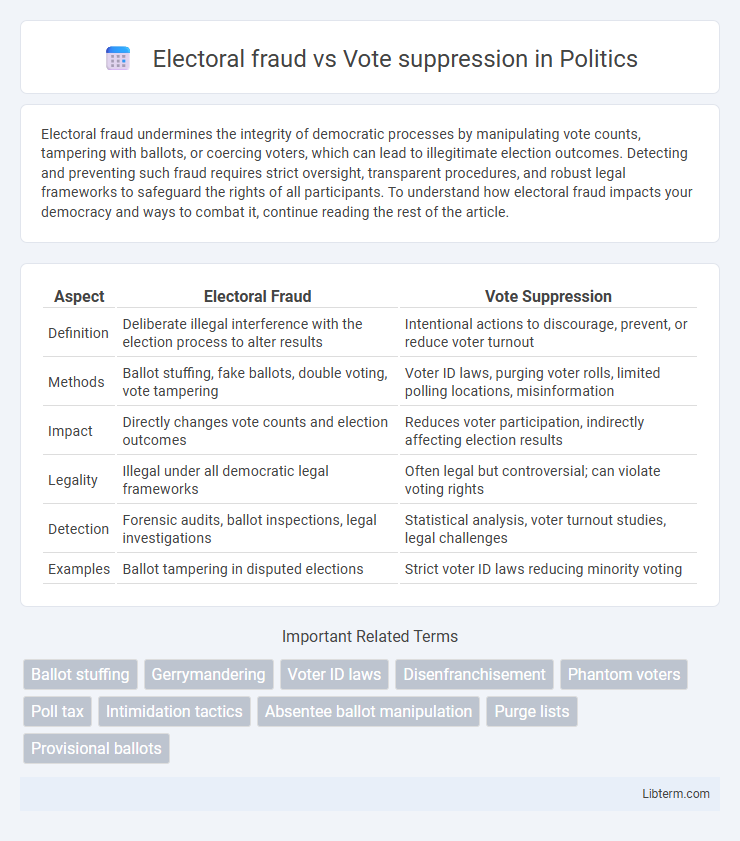Electoral fraud undermines the integrity of democratic processes by manipulating vote counts, tampering with ballots, or coercing voters, which can lead to illegitimate election outcomes. Detecting and preventing such fraud requires strict oversight, transparent procedures, and robust legal frameworks to safeguard the rights of all participants. To understand how electoral fraud impacts your democracy and ways to combat it, continue reading the rest of the article.
Table of Comparison
| Aspect | Electoral Fraud | Vote Suppression |
|---|---|---|
| Definition | Deliberate illegal interference with the election process to alter results | Intentional actions to discourage, prevent, or reduce voter turnout |
| Methods | Ballot stuffing, fake ballots, double voting, vote tampering | Voter ID laws, purging voter rolls, limited polling locations, misinformation |
| Impact | Directly changes vote counts and election outcomes | Reduces voter participation, indirectly affecting election results |
| Legality | Illegal under all democratic legal frameworks | Often legal but controversial; can violate voting rights |
| Detection | Forensic audits, ballot inspections, legal investigations | Statistical analysis, voter turnout studies, legal challenges |
| Examples | Ballot tampering in disputed elections | Strict voter ID laws reducing minority voting |
Understanding Electoral Fraud: Definitions and Types
Electoral fraud encompasses illegal activities aimed at disrupting or altering the outcome of elections, such as ballot stuffing, voter impersonation, and tampering with vote counts. Vote suppression involves tactics designed to discourage or prevent specific groups from voting, including strict voter ID laws, purging voter rolls, and limiting polling access. Recognizing these distinctions is crucial for addressing election integrity and ensuring democratic participation.
What is Vote Suppression? Key Tactics Explained
Vote suppression involves deliberate strategies to reduce voter turnout and undermine the electoral process, targeting specific groups to limit their participation. Key tactics include strict voter ID laws, purging voter rolls, limiting early voting, closing polling places in marginalized areas, and misinformation campaigns. These methods create barriers that disproportionately affect minorities, the elderly, and low-income voters, skewing election results.
Historical Examples of Electoral Fraud
Historical examples of electoral fraud include the notorious Tammany Hall elections in 19th-century New York, where vote buying and ballot stuffing were rampant, and the 1948 Texas Democratic primary, marked by ballot tampering and intimidation tactics. These incidents demonstrate systematic attempts to manipulate election outcomes by altering vote counts or falsifying results. Such fraudulent practices contrast with vote suppression, which primarily involves obstructing or discouraging voter participation rather than tampering with votes directly.
Notorious Incidents of Vote Suppression
Notorious incidents of vote suppression include the 2018 Georgia gubernatorial election, where tactics such as purging voter rolls and strict ID requirements disproportionately affected minority voters. The 2013 Shelby County v. Holder Supreme Court decision invalidated key provisions of the Voting Rights Act, leading to increased state-level restrictions that suppressed turnout in historically marginalized communities. These measures contrast with rare and less impactful cases of electoral fraud, underscoring vote suppression as a significant barrier to democratic participation.
Electoral Fraud vs Vote Suppression: Key Differences
Electoral fraud involves illegal interference with the election process, such as ballot tampering or vote buying, directly altering vote counts or election outcomes. Vote suppression refers to strategies or policies that prevent or discourage specific groups from voting, including strict voter ID laws, reduced polling places, or misinformation campaigns. The key difference lies in electoral fraud actively manipulating votes, whereas vote suppression restricts voter participation, impacting voter turnout more than vote accuracy.
Impact on Democracy: Fraud’s Consequences
Electoral fraud undermines democratic integrity by eroding public trust in election outcomes and weakening the legitimacy of elected officials. This deception distorts the representational accuracy of voting results, often leading to political instability and reduced voter participation. Persistent fraud damages democratic institutions by fostering cynicism and disengagement among citizens, impeding the fundamental democratic principle of fair and free elections.
Vote Suppression and Voter Disenfranchisement
Vote suppression refers to tactics that hinder eligible voters from casting their ballots, including strict ID laws, purging voter rolls, and limiting polling locations, disproportionately affecting minority and low-income communities. These practices lead to voter disenfranchisement by effectively denying individuals their fundamental right to participate in the democratic process. Understanding the distinction between vote suppression and electoral fraud is crucial, as suppression undermines election integrity by restricting access rather than altering vote counts.
Detection and Prevention Methods for Electoral Fraud
Electoral fraud detection relies on advanced technologies such as blockchain voting systems, biometric verification, and rigorous audit trails to ensure ballot integrity and prevent tampering. Prevention methods include voter education programs, transparent ballot handling procedures, and robust legal frameworks enforcing strict penalties to deter fraudulent activities. Independent election monitoring organizations and real-time data analytics also play critical roles in identifying irregularities and enhancing overall electoral transparency.
Combating Vote Suppression: Legal and Social Strategies
Combating vote suppression requires robust legal frameworks that enforce strict penalties for discriminatory practices such as voter ID laws and polling place closures targeting marginalized communities. Social strategies involve grassroots mobilization, voter education campaigns, and coalition-building among civil rights organizations to increase voter turnout and awareness. Integrating technology for transparent voter registration and reporting mechanisms also strengthens defenses against suppression tactics.
Building Trust in Elections: Policies for Integrity
Electoral fraud involves illegal interference with the election process, such as ballot stuffing or tampering, whereas vote suppression entails tactics that hinder voter participation, including strict ID laws and limited polling access. Implementing transparent auditing procedures, robust voter identification systems, and equitable access to polling stations strengthens the integrity of elections. Policies promoting accountability, independent oversight, and public education foster trust by ensuring that every legitimate vote is counted and that voting barriers are minimized.
Electoral fraud Infographic

 libterm.com
libterm.com